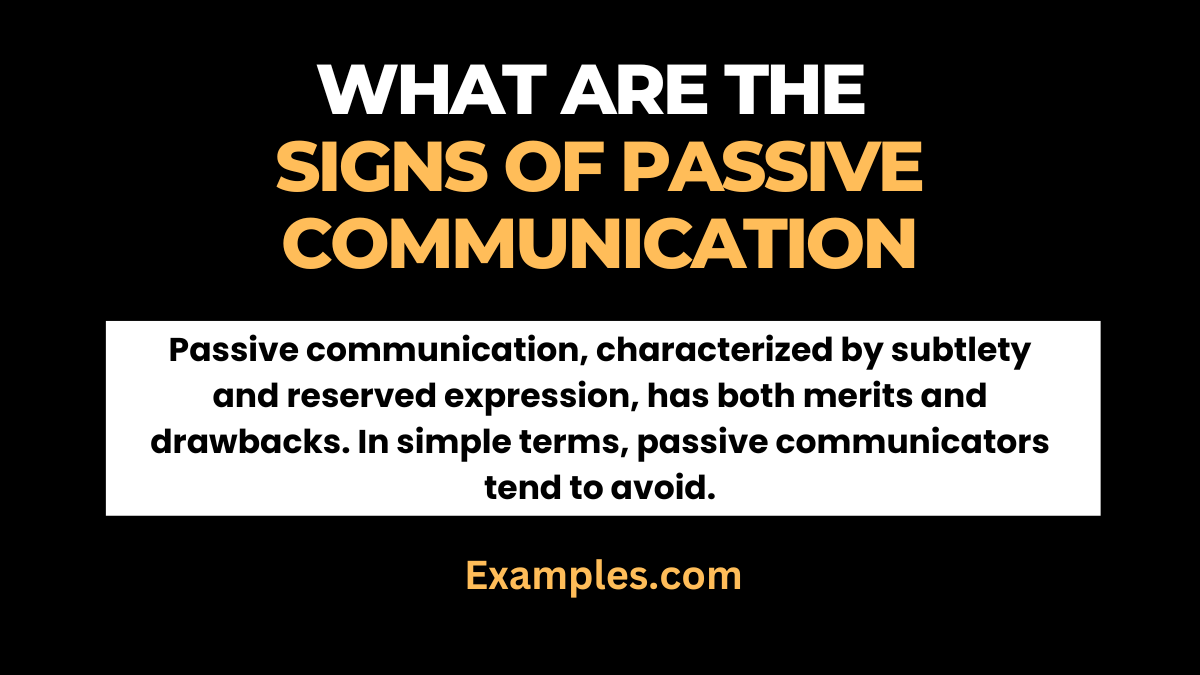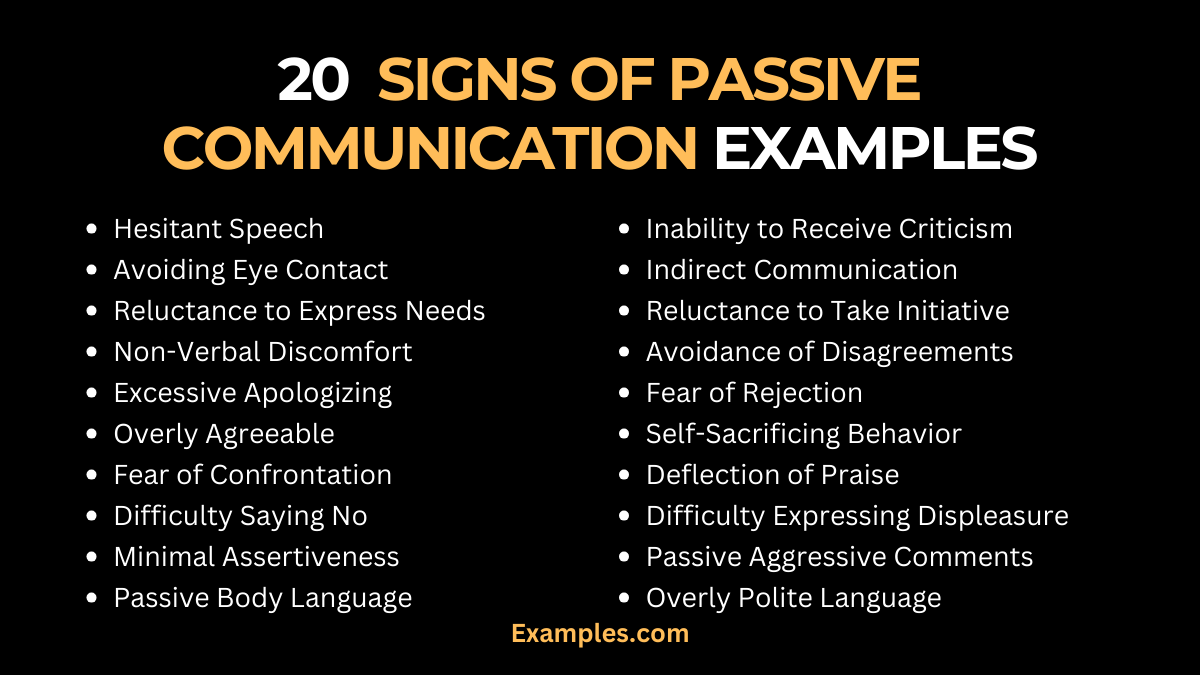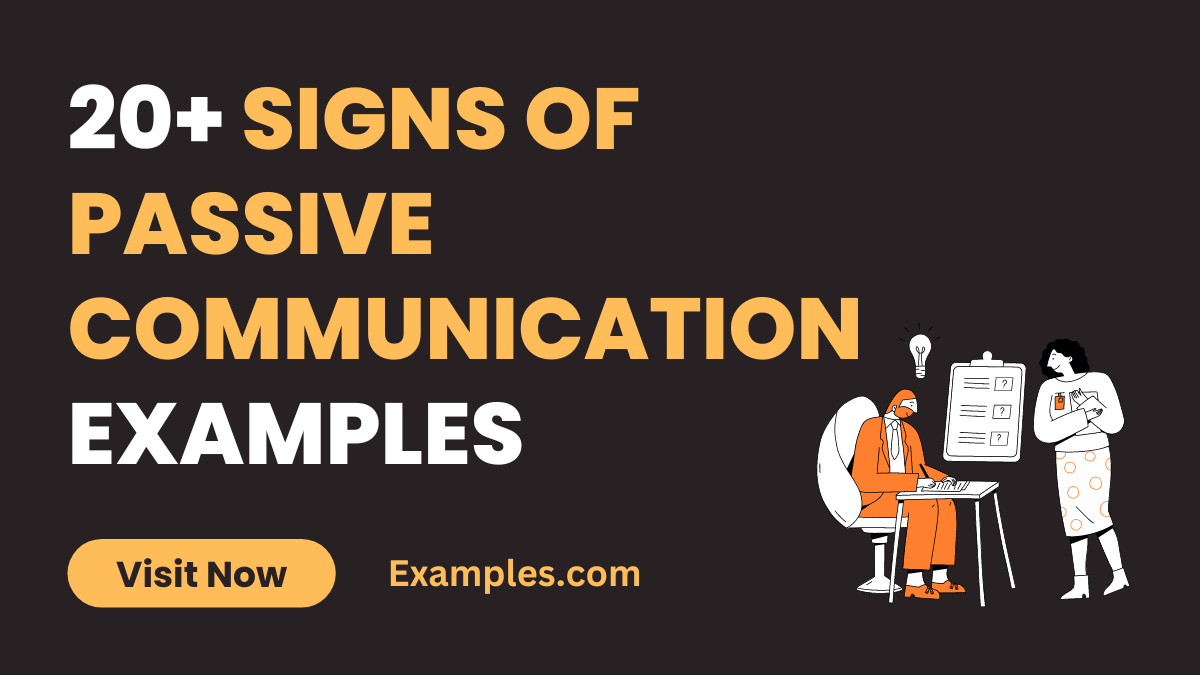19+ Signs of Passive Communication Examples
Embark on a journey to decipher the nuanced signs of passive communication with our comprehensive guide. Delve into the intricacies of nonverbal and verbal cues that reveal passive behaviour. Explore vivid examples to enhance your understanding, equipping you to navigate social and professional interactions effectively. This guide provides invaluable insights into recognizing, addressing, and refining communication patterns for more meaningful connections.
What are the Signs of Passive Communication?

Unravel the subtle indicators of passive communication, where unspoken cues speak volumes. In simple terms, passive communication manifests through hesitant speech, avoiding eye contact, and a reluctance to express needs. Providing a straightforward understanding of its signs and how they shape interpersonal dynamics. Decode the nonverbal and verbal signals that define this communication style.
20 Signs of Passive Communication Examples
Explore the intricacies of passive communication through 20 distinct signs, each unveiling the subtle language of unspoken cues. From hesitant speech to avoiding eye contact, these indicators shape interpersonal dynamics. Discover the benefits of recognizing these signs and enhance your communication skills effortlessly.

- Hesitant Speech:
- Example: Choosing words carefully, hesitating to assert opinions during team discussions.
- Avoiding Eye Contact:
- Example: Steering clear of direct eye contact to sidestep confrontations or disagreements.
- Reluctance to Express Needs:
- Example: Shying away from expressing personal needs or desires in social settings.
- Non-Verbal Discomfort:
- Example: Displaying physical discomfort or unease through fidgeting or nervous gestures.
- Excessive Apologizing:
- Example: Over-apologizing for trivial matters, avoiding potential conflicts.
- Overly Agreeable:
- Example: Always agreeing with others to maintain a harmonious atmosphere.
- Fear of Confrontation:
- Example: Avoiding difficult conversations or conflicts to prevent tension.
- Difficulty Saying No:
- Example: Finding it challenging to decline requests or set personal boundaries.
- Minimal Assertiveness:
- Example: Lacking assertiveness in expressing opinions or desires.
- Passive Body Language:
- Example: Closed-off body language, avoiding open gestures or expressions.
- Inability to Receive Criticism:
- Example: Reacting defensively or negatively to constructive criticism.
- Indirect Communication:
- Example: Conveying messages indirectly, relying on hints or gestures.
- Reluctance to Take Initiative:
- Example: Waiting for instructions rather than proactively taking initiative.
- Avoidance of Disagreements:
- Example: Sidestepping disagreements by remaining silent during discussions.
- Fear of Rejection:
- Example: Avoiding expressing personal feelings to prevent potential rejection.
- Self-Sacrificing Behaviour:
- Example: Prioritizing others’ needs over personal well-being.
- Deflection of Praise:
- Example: Downplaying personal achievements when praised by colleagues.
- Difficulty Expressing Displeasure:
- Example: Struggling to communicate displeasure or dissatisfaction directly.
- Passive Aggressive Comments:
- Example: Making sarcastic or passive-aggressive remarks to convey dissatisfaction.
- Overly Polite Language:
- Example: Using overly polite language to avoid causing discomfort in conversations.
Signs of Passive Communication in Verbal and Nonverbal Communication
Explore the intricate language of passive communication through verbal and nonverbal cues. Subtle signs like vague language, lack of eye contact, or hesitancy in speech reveal a passive communicator’s tendencies. This guide deciphers nuanced signals, enhancing your awareness in various communication contexts.
- Vague Language:
- Using ambiguous terms to avoid committing to a clear stance.
- Lack of Eye Contact:
- Avoiding direct eye contact during conversations to evade confrontation.
- Hesitancy in Speech:
- Speaking with uncertainty, hesitant to express opinions or needs.
- Over-Apologizing:
- Apologizing excessively, even for minor or non-existent faults.
- Indirect Requests:
- Expressing needs indirectly, expecting others to interpret cues.
- Subdued Voice Tone:
- Speaking softly or with a low tone to downplay assertiveness.
- Reluctance to Disagree:
- Avoiding disagreements or differing opinions to maintain harmony.
- Overly Polite Language:
- Using excessively polite language to prevent discomfort or conflict.
- Non-Committal Statements:
- Making vague or non-committal statements to avoid commitment.
- Deflection of Responsibility:
- Shifting blame or responsibility to others to avoid accountability.
Signs of Passive Communication at the Workplace
Recognize signs of passive communication in the workplace to navigate professional dynamics effectively. From reluctance to express ideas to fear of confrontation, these signs impact teamwork and productivity. This guide sheds light on workplace-specific indicators, offering insights into creating a communicatively healthy work environment.

- Reluctance to Express Ideas:
- Holding back innovative ideas or suggestions during team discussions.
- Avoidance of Leadership Roles:
- Stepping away from leadership roles due to a preference for passivity.
- Fear of Confrontation at Work:
- Shying away from addressing workplace conflicts to avoid tension.
- Difficulty Giving Constructive Feedback:
- Struggling to provide constructive criticism due to fear of upsetting others.
- Passive Resistance to Change:
- Resisting changes passively, without openly expressing concerns or ideas.
- Failure to Set Boundaries:
- Struggling to establish and maintain professional boundaries at work.
- Avoidance of Networking Opportunities:
- Skipping networking events or opportunities due to discomfort.
- Overreliance on Others’ Decisions:
- Depending excessively on others’ decisions, avoiding personal responsibility.
- Inability to Negotiate:
- Finding it challenging to negotiate for personal or professional interests.
- Passive Participation in Meetings:
- Participating passively in meetings, without actively contributing ideas or opinions.
What Does Passive Behaviour Look Like?
Passive behaviour manifests through subtle cues, both verbal and nonverbal, shaping communication dynamics. Recognizing these signs is pivotal for understanding passive communication. From hesitant speech to avoiding eye contact, this guide delves into the nuanced expressions that characterize passive behaviour. Explore how a reluctance to express needs or an avoidance of confrontation paints a vivid picture of passive communication. Gain insights into deciphering these signs to navigate interactions effectively.
What are the Characteristics of a Passive Communication
Passive communication is adorned with distinctive characteristics that manifest in both verbal and nonverbal expressions. Recognizing these signs is crucial for fostering effective interpersonal dynamics. In this comprehensive guide, we delve into the nuanced characteristics of passive communication, offering insights into subtle cues, behaviours, and patterns that define this communication style.
- Reluctance to Express Opinions: Passive communicators often hesitate to express their opinions, contributing to a lack of assertiveness.
- Avoidance of Conflict: A characteristic trait is the avoidance of conflicts, as passive individuals steer clear of confrontations to maintain harmony.
- Overuse of Apologies: Apologizing excessively, even for minor issues or situations not within their control, is a common trait.
- Indirect Communication: Passive communicators may convey their messages indirectly, relying on hints or subtle gestures.
- Difficulty Saying No: Saying no or setting boundaries becomes challenging, leading to overcommitment or discomfort.
- Reluctance to Take Initiative: Passive individuals often wait for instructions and may struggle to proactively take initiative.
- Fear of Rejection: There’s a noticeable fear of rejection, causing passive communicators to avoid expressing personal feelings.
- Minimal Assertiveness: Assertiveness is lacking, and passive communicators may struggle to assert their needs or desires.
- Non-Verbal Submissiveness: Subdued body language, avoiding eye contact, and overall non-verbal submissiveness are prevalent.
- Overly Polite Language: Communication is marked by an excess of politeness, often to avoid causing discomfort or disagreement.
In conclusion, this guide illuminates the intricate world of passive communication, unraveling its subtle signs and providing practical examples. By understanding these cues, readers can navigate social and professional scenarios with heightened awareness. Empower yourself to decode nonverbal and verbal signals, fostering effective and meaningful interactions. Elevate your communication skills through this comprehensive exploration.
19+ Signs of Passive Communication Examples

Embark on a journey to decipher the nuanced signs of passive communication with our comprehensive guide. Delve into the intricacies of nonverbal and verbal cues that reveal passive behaviour. Explore vivid examples to enhance your understanding, equipping you to navigate social and professional interactions effectively. This guide provides invaluable insights into recognizing, addressing, and refining communication patterns for more meaningful connections.
What are the Signs of Passive Communication?

Unravel the subtle indicators of passive communication, where unspoken cues speak volumes. In simple terms, passive communication manifests through hesitant speech, avoiding eye contact, and a reluctance to express needs. Providing a straightforward understanding of its signs and how they shape interpersonal dynamics. Decode the nonverbal and verbal signals that define this communication style.
20 Signs of Passive Communication Examples
Explore the intricacies of passive communication through 20 distinct signs, each unveiling the subtle language of unspoken cues. From hesitant speech to avoiding eye contact, these indicators shape interpersonal dynamics. Discover the benefits of recognizing these signs and enhance your communication skills effortlessly.

Hesitant Speech:
Example: Choosing words carefully, hesitating to assert opinions during team discussions.
Avoiding Eye Contact:
Example: Steering clear of direct eye contact to sidestep confrontations or disagreements.
Reluctance to Express Needs:
Example: Shying away from expressing personal needs or desires in social settings.
Non-Verbal Discomfort:
Example: Displaying physical discomfort or unease through fidgeting or nervous gestures.
Excessive Apologizing:
Example: Over-apologizing for trivial matters, avoiding potential conflicts.
Overly Agreeable:
Example: Always agreeing with others to maintain a harmonious atmosphere.
Fear of Confrontation:
Example: Avoiding difficult conversations or conflicts to prevent tension.
Difficulty Saying No:
Example: Finding it challenging to decline requests or set personal boundaries.
Minimal Assertiveness:
Example: Lacking assertiveness in expressing opinions or desires.
Passive Body Language:
Example: Closed-off body language, avoiding open gestures or expressions.
Inability to Receive Criticism:
Example: Reacting defensively or negatively to constructive criticism.
Indirect Communication:
Example: Conveying messages indirectly, relying on hints or gestures.
Reluctance to Take Initiative:
Example: Waiting for instructions rather than proactively taking initiative.
Avoidance of Disagreements:
Example: Sidestepping disagreements by remaining silent during discussions.
Fear of Rejection:
Example: Avoiding expressing personal feelings to prevent potential rejection.
Self-Sacrificing Behaviour:
Example: Prioritizing others’ needs over personal well-being.
Deflection of Praise:
Example: Downplaying personal achievements when praised by colleagues.
Difficulty Expressing Displeasure:
Example: Struggling to communicate displeasure or dissatisfaction directly.
Passive Aggressive Comments:
Example: Making sarcastic or passive-aggressive remarks to convey dissatisfaction.
Overly Polite Language:
Example: Using overly polite language to avoid causing discomfort in conversations.
Signs of Passive Communication in Verbal and Nonverbal Communication
Explore the intricate language of passive communication through verbal and nonverbal cues. Subtle signs like vague language, lack of eye contact, or hesitancy in speech reveal a passive communicator’s tendencies. This guide deciphers nuanced signals, enhancing your awareness in various communication contexts.
Vague Language:
Using ambiguous terms to avoid committing to a clear stance.
Lack of Eye Contact:
Avoiding direct eye contact during conversations to evade confrontation.
Hesitancy in Speech:
Speaking with uncertainty, hesitant to express opinions or needs.
Over-Apologizing:
Apologizing excessively, even for minor or non-existent faults.
Indirect Requests:
Expressing needs indirectly, expecting others to interpret cues.
Subdued Voice Tone:
Speaking softly or with a low tone to downplay assertiveness.
Reluctance to Disagree:
Avoiding disagreements or differing opinions to maintain harmony.
Overly Polite Language:
Using excessively polite language to prevent discomfort or conflict.
Non-Committal Statements:
Making vague or non-committal statements to avoid commitment.
Deflection of Responsibility:
Shifting blame or responsibility to others to avoid accountability.
Signs of Passive Communication at the Workplace
Recognize signs of passive communication in the workplace to navigate professional dynamics effectively. From reluctance to express ideas to fear of confrontation, these signs impact teamwork and productivity. This guide sheds light on workplace-specific indicators, offering insights into creating a communicatively healthy work environment.

Reluctance to Express Ideas:
Holding back innovative ideas or suggestions during team discussions.
Avoidance of Leadership Roles:
Stepping away from leadership roles due to a preference for passivity.
Fear of Confrontation at Work:
Shying away from addressing workplace conflicts to avoid tension.
Difficulty Giving Constructive Feedback:
Struggling to provide constructive criticism due to fear of upsetting others.
Passive Resistance to Change:
Resisting changes passively, without openly expressing concerns or ideas.
Failure to Set Boundaries:
Struggling to establish and maintain professional boundaries at work.
Avoidance of Networking Opportunities:
Skipping networking events or opportunities due to discomfort.
Overreliance on Others’ Decisions:
Depending excessively on others’ decisions, avoiding personal responsibility.
Inability to Negotiate:
Finding it challenging to negotiate for personal or professional interests.
Passive Participation in Meetings:
Participating passively in meetings, without actively contributing ideas or opinions.
What Does Passive Behaviour Look Like?
Passive behaviour manifests through subtle cues, both verbal and nonverbal, shaping communication dynamics. Recognizing these signs is pivotal for understanding passive communication. From hesitant speech to avoiding eye contact, this guide delves into the nuanced expressions that characterize passive behaviour. Explore how a reluctance to express needs or an avoidance of confrontation paints a vivid picture of passive communication. Gain insights into deciphering these signs to navigate interactions effectively.
What are the Characteristics of a Passive Communication
Passive communication is adorned with distinctive characteristics that manifest in both verbal and nonverbal expressions. Recognizing these signs is crucial for fostering effective interpersonal dynamics. In this comprehensive guide, we delve into the nuanced characteristics of passive communication, offering insights into subtle cues, behaviours, and patterns that define this communication style.
Reluctance to Express Opinions: Passive communicators often hesitate to express their opinions, contributing to a lack of assertiveness.
Avoidance of Conflict: A characteristic trait is the avoidance of conflicts, as passive individuals steer clear of confrontations to maintain harmony.
Overuse of Apologies: Apologizing excessively, even for minor issues or situations not within their control, is a common trait.
Indirect Communication: Passive communicators may convey their messages indirectly, relying on hints or subtle gestures.
Difficulty Saying No: Saying no or setting boundaries becomes challenging, leading to overcommitment or discomfort.
Reluctance to Take Initiative: Passive individuals often wait for instructions and may struggle to proactively take initiative.
Fear of Rejection: There’s a noticeable fear of rejection, causing passive communicators to avoid expressing personal feelings.
Minimal Assertiveness: Assertiveness is lacking, and passive communicators may struggle to assert their needs or desires.
Non-Verbal Submissiveness: Subdued body language, avoiding eye contact, and overall non-verbal submissiveness are prevalent.
Overly Polite Language: Communication is marked by an excess of politeness, often to avoid causing discomfort or disagreement.
In conclusion, this guide illuminates the intricate world of passive communication, unraveling its subtle signs and providing practical examples. By understanding these cues, readers can navigate social and professional scenarios with heightened awareness. Empower yourself to decode nonverbal and verbal signals, fostering effective and meaningful interactions. Elevate your communication skills through this comprehensive exploration.


